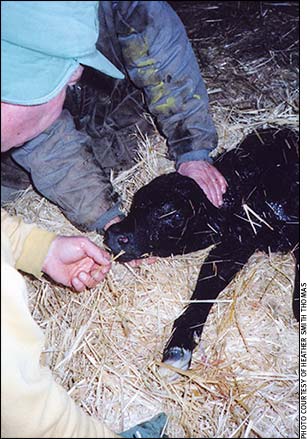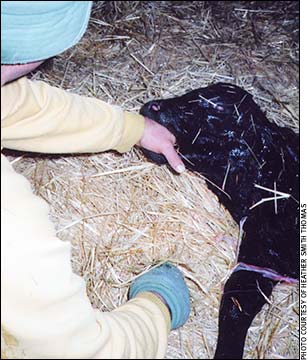Giving CPR to a Newborn Calf
Veterinarian gives tips on calf resuscitation.
In a normal, easy birth, the calf is stimulated to start breathing as soon as the umbilical cord breaks or his face and nose are uncovered when the amniotic sac comes off his head.
Sometimes after a hard birth, a backward birth, or even a normal birth when the sac doesn’t break, the calf was without oxygen too long and can’t start breathing. If the cord detached during birth, he will die unless he starts breathing quickly. The calf may be limp, unconscious and have blue gums. At first glance you might think he’s dead, until you put a hand against the ribcage and feel his heart beating.

If the calf is not breathing, clear fluid away from his nose with your fingers and tickle the inside of one nostril with a clean piece of hay or straw.
If he’s not breathing, clear fluid away from his nose with your fingers and tickle the inside of one nostril with a clean piece of hay or straw. This usually makes him cough and take a breath. If he’s unconscious and won’t start breathing, give artificial respiration.
Traditionally, compromised calves, those that are not breathing, or that have fluid in their airways, were held up by their hind legs. Stockmen and veterinarians thought this would allow fluid to drain from the airways. Today veterinarians don’t recommend this strategy, since most of the fluids that drain from an upside-down calf are stomach fluids that are important to health. Holding him up by the hind legs puts pressure on his diaphragm from abdominal organs, interfering with normal breathing movements. It’s better to just use a suction bulb to clear the airways.
If a calf was stressed during birth and doesn’t begin breathing immediately, it may be because he is suffering from acidosis, a pH imbalance in his body caused by stress and shortage of oxygen, which has an adverse effect on proper function of heart and lungs. It may take several hours or several days for his body to correct this, according to Matt Miesner, veterinarian and clinical associate professor and section head of Livestock Services at the Kansas State University College of Veterinary Medicine. If a calf is not breathing, some veterinarians administer a little bicarbonate intravenously to reverse acidosis, and epinephrine to help stimulate the calf.

If the calf is limp, unconscious and not breathing, but his heart is still beating, there’s a chance the calf could be resuscitated. First, clear the airways. Roll him onto his breastbone in an upright position with his chin resting on the ground and nose as low as possible to allow fluid to drain from his nostrils. You can also use a suction bulb or a turkey-baster bulb.
“Breathing stimulants like doxapram can also be very effective if given within a few minutes of pulling a calf,” says Miesner. Even if the calf is breathing, he may still need help to recover from a difficult birth.
If he is limp, unconscious and not breathing, but his heart is still beating, there’s a chance the calf could be resuscitated. First, clear the airways. Roll him onto his breastbone in an upright position with his chin resting on the ground and nose as low as possible to allow fluid to drain from his nostrils. You can also use a suction bulb or a turkey-baster bulb.
Then lay the calf on his side with head and neck extended, so air will go into his windpipe and not his esophagus and stomach when you blow into his nostril. This is similar to giving CPR to a person; you tilt the head back so the esophagus is closed off and the airway is open. It’s harder to do this in a calf, but if you can extend the head upward as you breathe into the nostril, this tends to close the throat, says Miesner. The air will follow the path of least resistance; you don’t want it going into the stomach.
Miesner suggests inserting a small-diameter tube into the nostril and windpipe to blow on, which is the most effective way to make sure you are blowing into the airway and not into the stomach. If you don’t have one, simply blow into one nostril.
Cover the other nostril tightly with your hand, holding his mouth shut to prevent air escaping, and gently blow a full breath, forcing air into the windpipe and lungs. Don’t blow rapidly or forcefully or you might rupture a lung. Blow until you see the chest rise. Then let the air come back out. Blow in another breath until the chest rises again. Continue filling the lungs and letting them empty until the calf starts breathing on his own. Usually, once body tissues become less starved for oxygen, heart rate will rise, and the calf will regain consciousness and start to breathe.

Editor’s Note: Heather Smith Thomas is a freelance writer and cattlewoman from Salmon, Idaho.






